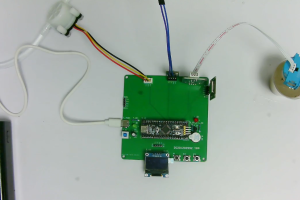设计说明书
总字数:19000+
摘要
随着水资源保护意识的提升与水环境治理工作的推进,河流水文参数(泥沙含量、压力、水流量)的实时监测成为水资源管理、防洪减灾及生态保护的重要环节。河水泥沙含量过高易导致河道淤积、水质恶化,影响水生生态平衡;压力异常可能反映水位变化,关联防洪安全;水流量波动则与水资源调配、灌溉供水密切相关。若这些参数无法及时监测与预警,可能引发河道治理滞后、防洪响应不及时等问题,因此研发一套能全面、精准监测河水泥沙含量及相关水文参数的系统具有重要现实意义。
本设计提出一种基于 STM32F103C8T6 单片机的河水泥沙含量监测系统。系统核心功能涵盖多参数监测、参数设置、数据显示、异常报警与远程传输:通过 TSW-30 浑浊度模块实时监测河水泥沙浓度,FSR402 薄膜压力模块采集河水压力,YF-S401 水流量模块获取河水流量数据;用户可通过按键灵活设置浑浊度、压力、水流量的阈值参数;OLED 显示屏实时显示各项监测值(泥沙浓度、压力、水流量)与对应的设置阈值,方便工作人员直观获取数据;当监测到任意参数大于预设最大值时,系统触发声光报警模块发出提醒,及时警示异常情况;同时,系统通过 ESP8266-12F-WiFi 模块将实时监测数据上传至阿里云平台,并同步下发至手机端,实现远程数据查看与实时监控。
该河水泥沙含量监测系统的应用价值在于,为水环境监测提供了一套全面、便捷且智能化的解决方案。通过多参数同步监测与实时报警,能帮助工作人员及时掌握河流水文状态,提前应对泥沙淤积、水位异常等问题;远程数据传输功能则打破了监测的时空限制,便于管理人员随时随地获取数据,为河道治理、水资源管理及生态保护决策提供可靠数据支持,助力提升水环境管理的效率与精准度。
关键词:。
关键词:STM32F103C8T6;泥沙含量;多参数监测;WiFi;阿里云平台;声光报警
Design and Implementation of River Sedimentation Monitoring System
Abstract
With the increasing awareness of water resource protection and the promotion of water environment governance, real-time monitoring of river hydrological parameters (sediment content, pressure, water flow) has become an important part of water resource management, flood control and disaster reduction, and ecological protection. Excessive sediment content in river water can lead to siltation and deterioration of water quality, affecting the balance of aquatic ecology; Abnormal pressure may reflect changes in water level and be related to flood control safety; The fluctuation of water flow is closely related to water resource allocation and irrigation water supply. If these parameters cannot be monitored and warned in a timely manner, it may lead to problems such as lagging river management and delayed flood control response. Therefore, developing a system that can comprehensively and accurately monitor the sediment content and related hydrological parameters of river water is of great practical significance.
This design proposes a river sediment content monitoring system based on STM32F103C8T6 microcontroller. The core functions of the system include multi parameter monitoring, parameter setting, data display, abnormal alarm, and remote transmission: real-time monitoring of river cement and sand concentration through TSW-30 turbidity module, collection of river water pressure through FSR402 membrane pressure module, and acquisition of river water flow data through YF-S401 water flow module; Users can flexibly set threshold parameters for turbidity, pressure, and water flow rate through buttons; The OLED display screen displays real-time monitoring values (sediment concentration, pressure, water flow rate) and corresponding set thresholds, making it convenient for staff to intuitively obtain data; When any parameter is detected to be greater than the preset maximum value, the system triggers the sound and light alarm module to issue a reminder and promptly alert of abnormal situations; At the same time, the system uploads real-time monitoring data to the Alibaba Cloud platform through the ESP8266-12F-WiFi module and synchronously distributes it to the mobile end, achieving remote data viewing and real-time monitoring.
The application value of the cement and sand content monitoring system in this river lies in providing a comprehensive, convenient, and intelligent solution for water environment monitoring. Through multi parameter synchronous monitoring and real-time alarm, it can help staff timely grasp the hydrological status of the river and respond to problems such as sedimentation and abnormal water levels in advance; The remote data transmission function breaks the time and space limitations of monitoring, making it easy for management personnel to access data anytime and anywhere, providing reliable data support for river management, water resource management, and ecological protection decisions, and helping to improve the efficiency and accuracy of water environment management.
Keywords:STM32F103C8T6; Sediment content; Multi parameter monitoring; WiFi; Alibaba Cloud platform; audible and visual alarm
目 录
1 绪论
1.1 研究背景及意义
1.2 国内外研究现状
1.3 主要内容
2 系统总体方案设计
2.1系统总体设计
2.2 主要模块方案选择
3 系统硬件设计
3.1 总体硬件框架
3.2 主控模块电路设计
3.3 泥沙浓度检测模块电路设计
3.4 压力(水位)检测模块电路设计
3.5 水流量检测模块电路设计
3.6 显示模块电路设计
3.7 按键模块电路设计
3.8 声光报警模块电路设计
3.9 WiFi 通信模块电路设计
4 系统程序设计
4.1 编程软件介绍
4.2 系统主流程设计
4.3 浑浊度检测模块子流程设计
4.4 水流量检测模块子流程设计
4.5 薄膜压力检测模块子流程设计
4.3 独立按键
4.7 OLED显示流程设计
4.8 WiFi模块子流程设计
5 实物制作与功能测试
5.1 实物制作
5.2 多参数监测与显示功能测试
5.3 按键参数设置功能测试
5.4 声光报警功能测试
5.5 WiFi 远程数据传输功能测试
6 总结
参考文献
致谢
附录A 原理图
附录B PCB
附录C 主程序

